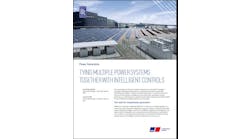NRDC and our allies at the Institute for Market Transformation (IMT) are proposing a change to the 2015 national model residential energy code that, for the first time ever, brings the nation’s largest homebuilders together with energy efficiency advocates in recommending a major code update. This proposal will provide builders much greater flexibility while saving a typical new home buyer between $300 and $850 annually on their utility bills.
Twenty of the nation’s biggest homebuilders, represented by their organization Leading Builders of America, today are joining NRDC and IMT to support a code change that would allow builders to comply with the energy-savings code by using a rating, such as the Home Energy Rating System, or HERS score, instead of having to install prescriptive energy efficiency measures specified by the code. These large builders are joined by almost 90 small builders and other building industry businesses and nonprofits across the country in support of this proposal.
But the anticipated high level of homeowner savings, as important as is it is, isn’t the biggest story here. Instead, it’s that this marks the first time in my almost 40 years of participating in code change proceedings that builders and efficiency advocates are jointly supporting a major upgrade in energy efficiency requirements. In fact, this proposal now has about 90 pledged supporters, including huge organizations like Masco Energy Services.
Why? Because we each see the proposal as a big win—not just for ourselves but for all concerned.
WHY ARE ENERGY-SAVINGS CODES IMPORTANT?
The code under consideration is the International Energy Conservation Code (IECC) which is developed by a nonprofit organization, the International Code Council (ICC), and adopted by many states and cities across the country.
From NRDC’s point of view, this code upgrade will cut energy bills and greenhouse gas emissions by 20 percent compared to the previous 2012 code, and by 40 percent compared to the 2006 code. Our proposed 2015 update will accumulate to a national cost savings of over $100 billion by 2030 compared to the 2006 code. Cumulative greenhouse gas emissions reductions through 2030 will be 560 million metric tons (MMT) of carbon dioxide pollution equivalent, approximately equal to the emissions produced by 158 coal-fired power plants in a year.
From the builders’ point of view, the change will allow energy code compliance basedon meeting a performance goal – known as an Energy Rating Index (ERI) – that allows buyers to estimate annual energy savings and compare efficiencies between homes in each of the eight U.S. climate zones rather than following a detailed checklist. The HERS score, which qualifies as an ERI, is a method already used for over one-third of all new homes.
The flexibility provided by the ERI approach allows builders to select the efficiency measures that cost the least and perform the best for each home. This makes a big difference: Leading Builders of America estimates that a level of energy performance that would have cost $3,000 extra using the checklist approach instead would cost only $1,300 with the HERS score approach, even counting the cost of the HERS rating.
This added flexibility helps everyone by creating competition in the energy efficiency suppliers’ industries as to who can save the most energy for the lowest cost. This leads to the kind of continual improvement we see in smart phones or computers, creating new jobs and new businesses and better products – and additional energy savings down the road.
Both NRDC and builders agree that moving to a whole house performance-based code is a necessary next step to achieving continual improvement in efficiency. In future energy codes, adding higher efficiencies using the prescriptive path will become increasingly difficult to justify on a cost-benefit basis and will be resisted on a measure by measure basis by builders.
From the consumer’s point of view, this will deliver 20 percent savings in utility bills compared to the 2012 code—which currently is only enforced in a few states and cities—and 40 percent compared to the 2006 code. NRDC estimates that the extra costs of the down payment for the more energy-efficient home will pay back in net monthly savings in just over six months. And that’s based on today’s cost of efficient construction—with increased competition for energy efficient components, the cost should decline substantially when the code is implemented, as has been the case for performance-based appliance standards.
Better still, consumers will have third-party verified information on their homes’ projected energy use. A house meeting this code requirement will have less than half the utility bills of a typical existing home built before energy codes were as demanding, or even existed. With a HERS rating, they can also demonstrate the home’s extra value to the next buyer for a better selling price.
Furthermore, the use of HERS ratings encourages builders to offer even greater energy savings than the minimum required.
HERS ratings are very reliable: one of the nation’s largest private warranty companies has even begun offering home energy guarantees of utility bills based on the HERS Index score ratings.
From the point of view of other businesses, those selling high-efficiency products will sell more of them. And all businesses benefit when consumers spend the money that they would have wasted on utility bills to buy things they really want. As these businesses sell more, they also generate more jobs.
HOMES WOULD COST LESS TO OWN AND OPERATE, TOO
Energy efficient homes meeting these code requirements also are more affordable because the monthly utility bill savings more than pay for the increase in mortgage payments. Unfortunately, at present mortgage lenders do not recognize this increased affordability.
But this can be changed: Leading Builders of America is also working with NRDC and IMT to pass the bipartisan SAVE Act, which will require lenders to consider utility cost savings based on HERS ratings when offering a mortgage. Such a change will increase the security of the loan for the lenders and investors, as well as allow would-be buyers to qualify for homes that they might not otherwise be able to.
WHAT CAN YOU DO?
Unfortunately, energy codes have not attracted the attention they deserve despite their immense impact on both consumer costs and greenhouse gas emissions. But with a broader coalition behind them, this upgrade could be the exception.
But first we need to get our proposal passed. Every local jurisdiction has code officials empowered to attend the International Codes Council’s meeting in Atlantic City this October where the 2015 code will be considered. Contact your mayor or city manager or county leadership and ask them to send representatives to the meeting and vote for our groundbreaking proposal—”proposal RE188-13, as amended by our jointly sponsored Public Comment.” For cities that are trying to be green and reduce utility bills for their citizens, and many of our most prominent municipalities are advertising themselves as the greenest in their region or even in the nation, supporting an advanced energy code is one of the most important actions they can take.
To read today’s news release, click here. For a list of supporters, click here. To read the fact sheet about the proposed code change, click here.
Dr. David Goldstein is a co-director of the Energy Program at the Natural Resources Defense Council. This piece was originally published at NRDC’s Switchboard blog and was reprinted with permission.







